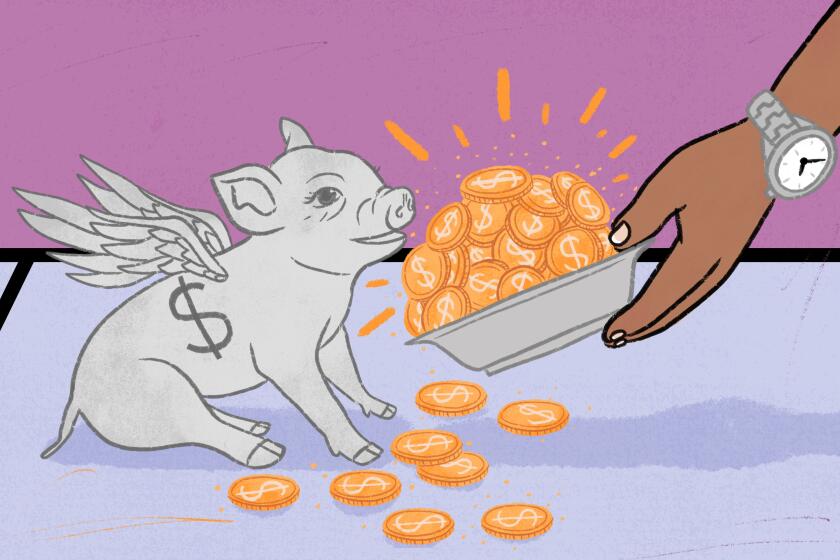Here are some strategies to survive inflation

- Share via
With inflation soaring to levels unseen since the 1970s, families are grappling with higher prices for nearly everything.
Basic strategies to survive inflation involve spending or saving less or earning more. If you’re retired, surviving inflation means using more of your savings — assuming that’s something that won’t leave you destitute when you’re older — or finding an acceptable side hustle.
Realize, too, that inflation has a lasting impact. The last high-inflation period in the U.S. lasted four years. And prices rarely go down. So, inflation builds on itself, leaving prices higher for a lifetime. Thus, when you consider inflation coping strategies, make sure you’ve picked an answer that you can live with long term.
How retirees can survive inflation
Inflation is often hardest on retirees, who are living on savings, investments and fixed sources of income, such as pensions and Social Security. So, we’ll start with how retirees can figure out their best option.
To figure out whether you’ll have enough to survive inflation without exhausting your savings, do a quick calculation.
Whether it’s going back to work part time, moving in with roommates or making do with less, older Americans are getting creative about retirement.
Look at how much money you get each month from fixed sources of income, such as pensions and Social Security. Compare that with how much you spend. If your monthly spending exceeds these sources of income, this spending gap is financed by pulling money from savings.
For instance, if you receive $2,000 a month from Social Security and pensions, but you spend $3,000 a month, you’ve got a $1,000 gap that’s funded through savings.
To answer the pivotal question of whether your savings will last as long as you do, add up the balances in your savings and investment accounts. Take that total and simply divide by your savings gap.
Let’s say you have $100,000 in retirement savings. You divide $100,000 by your monthly savings gap of $1,000 to find that your savings will last roughly 100 months — that’s 8.3 years — before the account is depleted. (Obviously, this is a simplistic calculation that could swing a bit in either direction, depending on investment returns, cost-of-living adjustments and your future spending. But the older you are, the more likely it is to be close.)
If you’re likely to live longer than your savings and you don’t have good ways to cut costs, you should consider a side hustle to fill some or all of your spending gap.
Don’t let the bear market keep you from retiring. But there are a bunch of other financial and emotional factors to consider before taking the leap.
How workers can survive inflation
If you are still working, you have more options. You can cut back; you can (at least temporarily) stop saving for long-term goals; or you can find ways to earn more money.
To cut back thoughtfully, separate your monthly expenses into necessities and discretionary spending.
What are necessities? Housing, utilities and food are the most obvious. Monthly payments on debts are also a necessary expense. So too are the transportation and miscellaneous expenses that allow you to get to work and do your job well.
The last thing you want to do in inflationary times is jeopardize the work that keeps income flowing into your household.
Now consider your discretionary expenses and separate them into high-priority and low-priority categories. New clothes for growing kids would be a high priority, for example, as would their school supplies. Things that you love, whether that’s eating out or cable TV, might also fall into the high-priority category. And saving for both long- and short-term goals is likely to be a priority for anyone who thinks ahead.
More than 7 million Californians have had no access to a workplace retirement program. Can the CalSavers program help?
But you may decide that you can’t currently afford school fundraisers or after-school sports. Perhaps your clothing, lunch or coffee/snack spending is out of whack. Maybe you need to cut the vacation and gift budget.
Saving for long-term goals should be part of your discretionary budget. And the more precious the goal, the higher the priority to save for it.
If you are likely to get significant raises that will close today’s budget gaps, you can temporarily suspend saving to cope with inflation. Just be sure to check back and resume savings as soon as those anticipated raises lift you into a position to better pay your bills.
If your necessary and high-priority spending exceeds the amount you have coming in each month, you need to look at how to earn more money. That may require asking for a raise or seeking higher-paying work.
If neither of those options is viable, consider doing a side hustle in your spare time.
Economically speaking, the vibes are off. Here’s what you should be doing with your money, according to financial experts.
Side hustles
There are literally thousands of different ways that you can make money in your free time. These include the well-known driving and delivery apps, such as Uber and DoorDash. But it also includes hundreds of professional and service-oriented portals that can help you earn money doing almost any job that you’re qualified for.
Dozens of sites also help find customers willing to rent your house, yard, swimming pool, RV, camping equipment and storage space. These can be particularly nice side hustle options for retirees who don’t want to go back to work but have accumulated assets that are underused.
Meanwhile, parents of young kids can earn money for things they’re doing anyway such as helping with homework and walking dogs.
Kristof is the editor of SideHusl.com, an independent website that reviews moneymaking opportunities in the gig economy.
More to Read
Inside the business of entertainment
The Wide Shot brings you news, analysis and insights on everything from streaming wars to production — and what it all means for the future.
You may occasionally receive promotional content from the Los Angeles Times.














